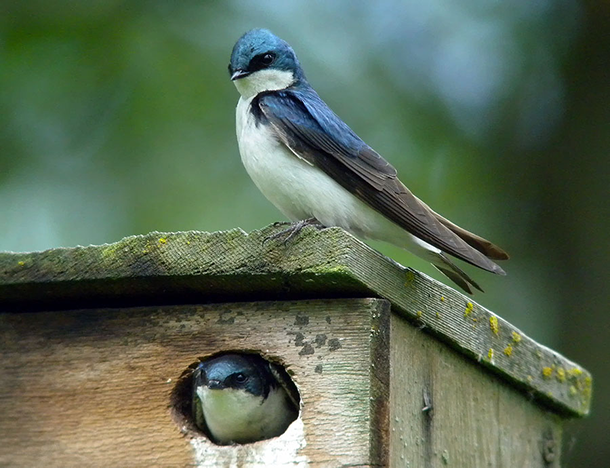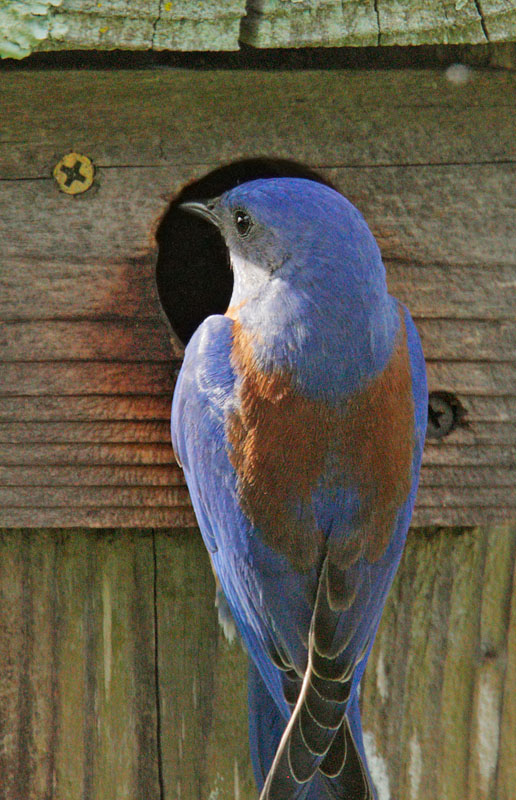BirdNote: Early Bird Gets the Nesting Site
Air Date: Week of February 26, 2016

Tree Swallow nestbox. (Photo: Mike Hamilton)
Competition for nesting sites is fierce as migrating birds return north for the summer months, but as BirdNote’s Michael Stein reports, clever bluebirds and the tree swallows beat the rush—staking their claim before others have a chance.
Transcript
[MUSIC - BIRDNOTE® THEME]
CURWOOD: The days are getting longer, and that brings thoughts of spring and its many pleasures. And principal among those are returning birds, as Michael Stein explains in today’s BirdNote.
BirdNote®
Nest Cavities – Book Early
[Rapid series of male Tree Swallow’s song-like notes]
A flash of glittering dark blue cuts through the gray of late February, as a male Tree Swallow glides low over a cattail marsh. The Tree Swallow’s liquid notes hint at spring’s approach.
[Repeat rapid series of male Tree Swallow’s song-like notes]
Where a broad, green pasture meets the forest edge, there is a second, even brighter flash of blue. A male bluebird alights on a fence post, the intense blue of its back glints in the welcome sunlight of late winter.
[A bit of Eastern Bluebird song]

Western Bluebird male protects his nesting site from competitors like the starlings and house sparrows. (Photo: Tom Grey©)
Tree Swallows and all three North American bluebird species are among the earliest northbound migrants to arrive, heralding spring a month before the equinox. Both species will nest only in cavities, such as old woodpecker holes or man-made nest-boxes. The supply of such specialized nest sites is limited. Competition is intense. By arriving so early, Tree Swallows and bluebirds improve their chances of finding unoccupied cavities – and they may fiercely guard a nest site until April, before actually nesting.
Both species benefit greatly from nest-box programs. But it is crucial to put up only nest-boxes with very specific hole-sizes that encourage these flashy blue migrants but deter non-native starlings and House Sparrows.
I’m Michael Stein.
###
Written by Bob Sundstrom
Song of the birds provided by The Macaulay Library of Natural Sounds at the Cornell Lab of Ornithology, Ithaca, New York. Tree Swallow recorded by G.F. Budney. Eastern Bluebird recorded by W.L. Hershberger.
Producer: John Kessler
Executive Producer: Chris Peterson
© 2016 Tune In to Nature.org - for Living on Earth
http://birdnote.org/show/nest-cavities-book-early
CURWOOD: You’ll find pictures at our website, LOE.org.
Links
Learn more about early competition for nesting sites on BirdNote
Tips for building and maintaining birdhouses
How to make a birdhouse for just about any bird
Audubon’s field guide to the Mountain Bluebird
More about the Mountain Bluebird from Cornell’s Lab of Ornithology
Audubon’s field guide to the Eastern Bluebird
More about the Eastern Bluebird from Cornell’s Lab of Ornithology
Audubon’s field guide to the Western Bluebird
More about the Western Bluebird from Cornell’s Lab of Ornithology
Living on Earth wants to hear from you!
Living on Earth
62 Calef Highway, Suite 212
Lee, NH 03861
Telephone: 617-287-4121
E-mail: comments@loe.org
Newsletter [Click here]
Donate to Living on Earth!
Living on Earth is an independent media program and relies entirely on contributions from listeners and institutions supporting public service. Please donate now to preserve an independent environmental voice.
NewsletterLiving on Earth offers a weekly delivery of the show's rundown to your mailbox. Sign up for our newsletter today!
 Sailors For The Sea: Be the change you want to sea.
Sailors For The Sea: Be the change you want to sea.
 The Grantham Foundation for the Protection of the Environment: Committed to protecting and improving the health of the global environment.
The Grantham Foundation for the Protection of the Environment: Committed to protecting and improving the health of the global environment.
 Contribute to Living on Earth and receive, as our gift to you, an archival print of one of Mark Seth Lender's extraordinary wildlife photographs. Follow the link to see Mark's current collection of photographs.
Contribute to Living on Earth and receive, as our gift to you, an archival print of one of Mark Seth Lender's extraordinary wildlife photographs. Follow the link to see Mark's current collection of photographs.
 Buy a signed copy of Mark Seth Lender's book Smeagull the Seagull & support Living on Earth
Buy a signed copy of Mark Seth Lender's book Smeagull the Seagull & support Living on Earth

